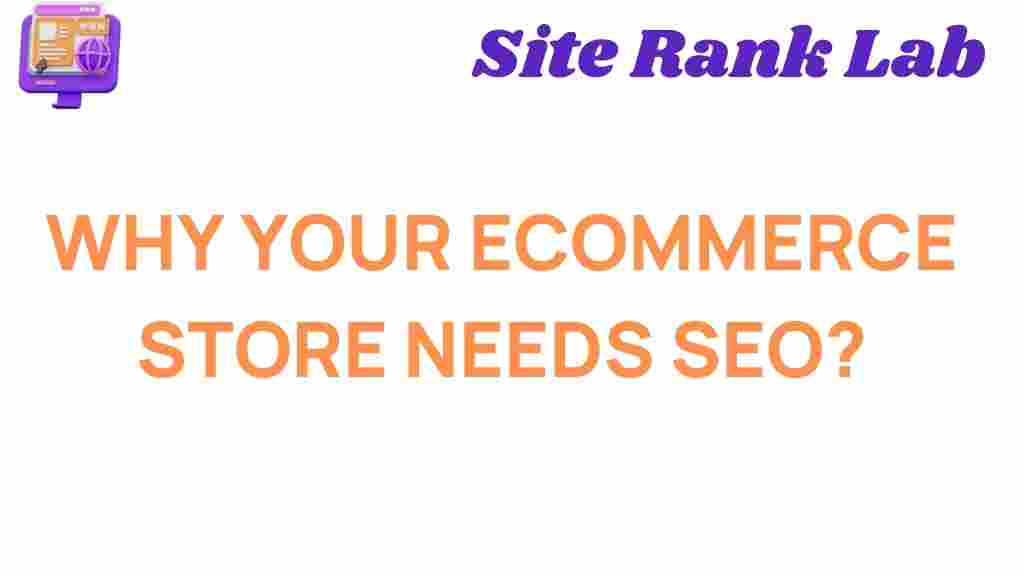Unlocking Success: Why Your E-commerce Store Needs SEO
In today’s digital marketplace, having an effective e-commerce strategy is crucial for success. With millions of online stores competing for attention, how do you stand out? The answer lies in Search Engine Optimization (SEO). This article explores the importance of SEO for your e-commerce store and how it can significantly enhance your online visibility, drive traffic, improve conversion rates, and engage customers effectively.
Understanding SEO in the Context of E-commerce
SEO is the practice of optimizing your website to rank higher in search engine results. For e-commerce businesses, this means optimizing product pages, improving site structure, and using targeted keywords to attract potential customers. The primary goal of SEO is to increase organic traffic, which is essential for boosting sales and building brand awareness.
The Importance of Online Visibility
Online visibility is paramount in the e-commerce landscape. Here’s why:
- Increased Traffic: The higher your site ranks on search engines, the more likely users will click on your link, leading to increased website traffic.
- Brand Credibility: Users tend to trust businesses that appear at the top of search results, associating high rankings with credibility.
- Cost-Effectiveness: SEO is often more cost-effective compared to paid advertising, providing long-term benefits without ongoing costs.
How SEO Enhances Conversion Rates
Having an e-commerce store is not enough; you need to convert your visitors into customers. Here’s how SEO contributes to improved conversion rates:
- Targeted Traffic: SEO helps you attract users who are actively searching for products you offer, leading to higher conversion potential.
- User Experience: A well-optimized website provides a better user experience, making it easier for customers to navigate and make purchases.
- Content Quality: SEO encourages high-quality content creation, which builds trust and encourages users to complete their purchases.
Steps to Implement SEO for Your E-commerce Store
Implementing SEO for your e-commerce store can seem daunting, but following these steps can streamline the process:
1. Keyword Research
Identify relevant keywords that your target audience is searching for. Use tools like Google Keyword Planner or SEMrush to find keywords that have a good search volume and low competition.
2. Optimize Product Pages
Your product pages are crucial for SEO. Ensure that each page includes:
- Keyword-Rich Titles: Include the primary keyword in the product title.
- Unique Descriptions: Write unique, engaging descriptions that include relevant keywords.
- High-Quality Images: Use optimized images with descriptive alt text to improve image searchability.
3. Improve Site Structure
A well-structured website enhances user experience and SEO. Consider the following:
- Clear Navigation: Ensure your site has a logical hierarchy, making it easy for users to find what they need.
- Mobile Responsiveness: Optimize your website for mobile devices, as a significant amount of traffic comes from smartphones.
- Fast Loading Times: Use tools like Google PageSpeed Insights to check your site’s loading speed and implement necessary improvements.
4. Create Quality Content
Content is king in the realm of SEO. Develop blog posts, guides, and videos that provide value to your audience. This not only improves search rankings but also enhances customer engagement.
5. Build Backlinks
Backlinks are links from other websites to your e-commerce store. They act as votes of confidence for search engines. Strategies for building backlinks include:
- Guest Blogging: Write articles for other websites in exchange for a link back to your site.
- Influencer Collaborations: Partner with influencers to promote your products and link to your store.
- Press Releases: Share newsworthy updates about your business to get featured in news articles.
Common SEO Challenges and Troubleshooting Tips
As you implement SEO, you may encounter challenges. Here are some common issues and how to address them:
1. Low Search Rankings
If your website isn’t ranking well, consider the following:
- Evaluate Your Keywords: Ensure you’re targeting the right keywords. Use long-tail keywords for better targeting.
- Improve Content Quality: Regularly update your content to keep it fresh and relevant.
- Check for Technical Issues: Use tools like Google Search Console to identify and fix technical problems.
2. High Bounce Rates
A high bounce rate indicates that visitors are leaving your site quickly. To reduce bounce rates, focus on:
- Improving Site Speed: Optimize images and reduce server response times.
- Enhancing User Experience: Make your website visually appealing and easy to navigate.
- Providing Relevant Content: Ensure that your landing pages meet user expectations based on search queries.
3. Low Conversion Rates
If your traffic is high but conversions are low, consider these strategies:
- Analyze User Behavior: Use tools like Google Analytics to understand how users interact with your site.
- Optimize Checkout Process: Simplify the checkout process to reduce cart abandonment.
- Implement Retargeting Campaigns: Use digital marketing techniques to re-engage users who didn’t convert initially.
The Role of Digital Marketing in E-commerce SEO
Digital marketing and SEO go hand in hand. While SEO focuses on organic traffic, digital marketing encompasses various strategies to promote your e-commerce business. Here’s how they intersect:
- Social Media Marketing: Share content and products on social media platforms to drive traffic and improve brand awareness.
- Email Marketing: Use targeted email campaigns to engage customers and encourage repeat purchases.
- PPC Advertising: Use pay-per-click advertising to supplement your SEO efforts and attract immediate traffic.
Conclusion: The Path to E-commerce Success
In the competitive world of e-commerce, leveraging SEO is not just beneficial; it’s essential. By focusing on improving your online visibility, driving quality website traffic, enhancing conversion rates, and fostering customer engagement, you position your business for long-term success. Remember, SEO is an ongoing process that requires dedication and adaptation to changing algorithms and market trends.
If you want to learn more about digital marketing strategies for your e-commerce store, check out this comprehensive guide. Additionally, for further insights into SEO, visit Moz’s SEO Learning Center.
Start implementing these strategies today and unlock the full potential of your e-commerce store!
This article is in the category SEO and created by SiteRankLab Team
